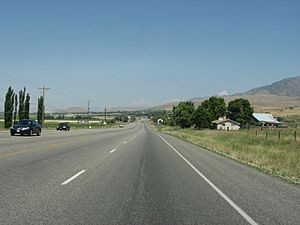Cache Valley facts for kids
Quick facts for kids Cache Valley |
|
|---|---|

Aerial view of the Wellsville Mountains at the southwestern end of the Cache Valley, September 2009
|
|
| Length | 50 mi (80 km) |
| Geography | |
| Country | United States |
| States | Utah and Idaho |
| Counties | Cache County, Utah and Franklin County, Idaho |
| Population centers | Logan, Utah and Preston, Idaho |
| Borders on | Bannock Range, Wellsville Mountains, Bear River Mountains and Wasatch Range |
Cache Valley is a beautiful valley located in northern Utah and southeastern Idaho, United States. It's home to the Logan metropolitan area. Long ago, in the 1800s, this valley was a busy place for mountain men who explored the American West. It was also the site of a very sad event in 1863, called the Bear River Massacre. Today, Cache Valley is growing fast, both in terms of its economy and the number of people living there.
| Top - 0-9 A B C D E F G H I J K L M N O P Q R S T U V W X Y Z |
History of Cache Valley
Before European explorers arrived, the Shoshone and other Native American groups lived in Cache Valley. Around 1818, a European explorer named Michel Bourdon discovered the valley. He was part of a fur-hunting trip led by Donald MacKenzie.
Why is it called Cache Valley?
After its discovery, the valley became a popular spot for annual gatherings of mountain men. These trappers worked for big fur companies like Hudson's Bay Company. They used a special method to keep their valuable trading goods safe. They would hide them in secret spots called "caches." This is how the valley got its name, "Cache Valley."
Early Settlers Arrive
In 1852, a man named William Gardner became the first permanent Anglo-American settler. He was a member of the Mormon faith. Before Mormons chose the Salt Lake Valley for their main settlement, a famous explorer named Jim Bridger even suggested Cache Valley. He thought it was a great place because it had lots of fresh water.
More Mormon settlers arrived in July 1856, led by Peter Maughan. They came through a place called Box Elder Canyon. More people continued to settle in the valley on September 15 of that year.
Protecting the Settlements
The early Anglo-American settlers formed a group called the Cache Valley Militia. This group helped protect them from what they saw as threats from Native Americans. Men from different towns volunteered to be "minute men." They would practice drills, act as watchmen, and quickly ride to help other communities if there were attacks.
The Bear River Massacre
On January 29, 1863, a very sad event happened. Soldiers from Camp Douglas, Utah, went to Cache Valley. At the request of some settlers, they attacked a Shoshone village very early in the morning. This village was located near the Bear River. This event is known as the Bear River Massacre.
It's hard to know the exact number of Shoshone people who died. But estimates suggest around 400 to 500 people were killed. This included many women and children. This event is still known as the largest massacre of Native American people by the United States government.
Communities in Cache Valley
Cache Valley is home to many towns and cities. These communities are located in two different counties: Cache County, Utah in Utah and Franklin County, Idaho in Idaho.
Utah Communities
Here are some of the towns in Cache County, Utah:
- Amalga
- Avon
- Benson
- Cache Junction
- Clarkston
- College Ward
- Cornish
- Cove
- Hyde Park
- Hyrum
- Lewiston
- Logan
- Mendon
- Millville
- Mt. Sterling
- Newton
- Nibley
- North Logan
- Paradise
- Petersboro
- Providence
- Richmond
- River Heights
- Smithfield
- Trenton
- Wellsville
- Young Ward
Idaho Communities
Here are some of the towns in Franklin County, Idaho:
- Banida
- Clifton
- Cub River
- Dayton
- Egypt
- Fairview
- Franklin
- Glendale
- Mapleton
- Oxford
- Preston
- Riverdale
- Thatcher
- Treasureton
- Weston
- Whitney
Getting Around Cache Valley
Several important roads run through Cache Valley. U.S. Highways 89 and 91 enter the valley together. They split in downtown Logan. US-89 heads northeast into Logan Canyon and then to Bear Lake. US-91 goes north into Idaho and eventually connects with I-15.
Many state highways also cross the valley. In Idaho, these include State Highways 34 and 36. In Utah, you'll find SR-23, SR-30, SR-101, SR-142, SR-165, SR-200, and SR-218.
Public Transportation
The Cache Valley Transit District (CVTD) provides a bus system in the valley. The best part is that it's completely free to ride! CVTD mainly serves the Logan area, but it also offers shuttle service to Preston.
Airports
Cache Valley has two airports: the Logan-Cache Airport and Preston Airport. These airports do not offer commercial flights. If you need to fly, the Salt Lake City International Airport is less than a two-hour drive away.



